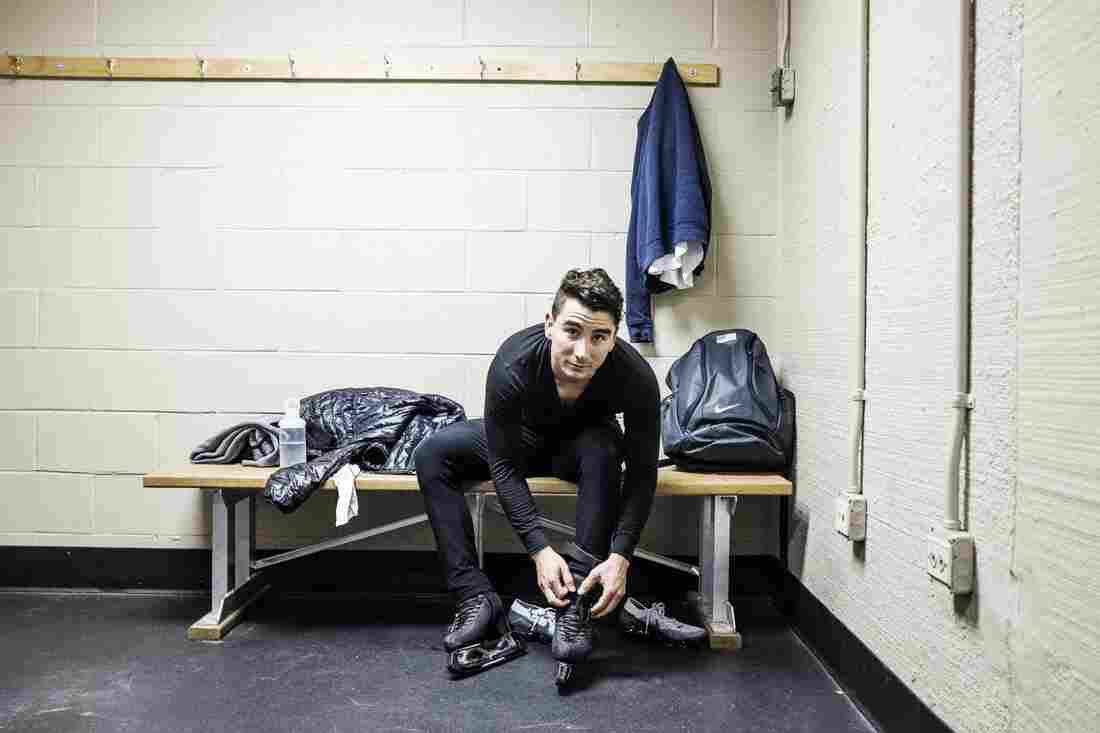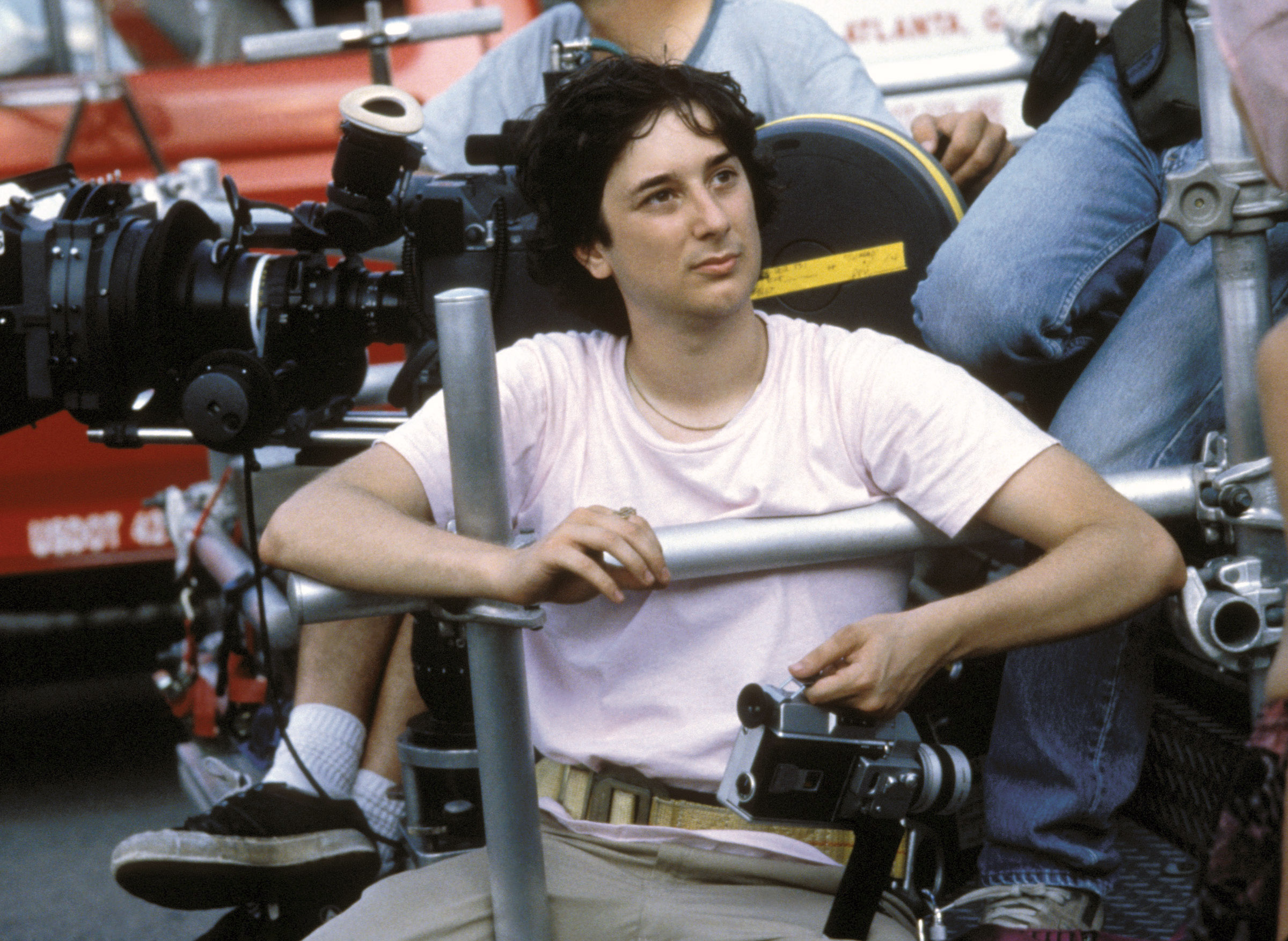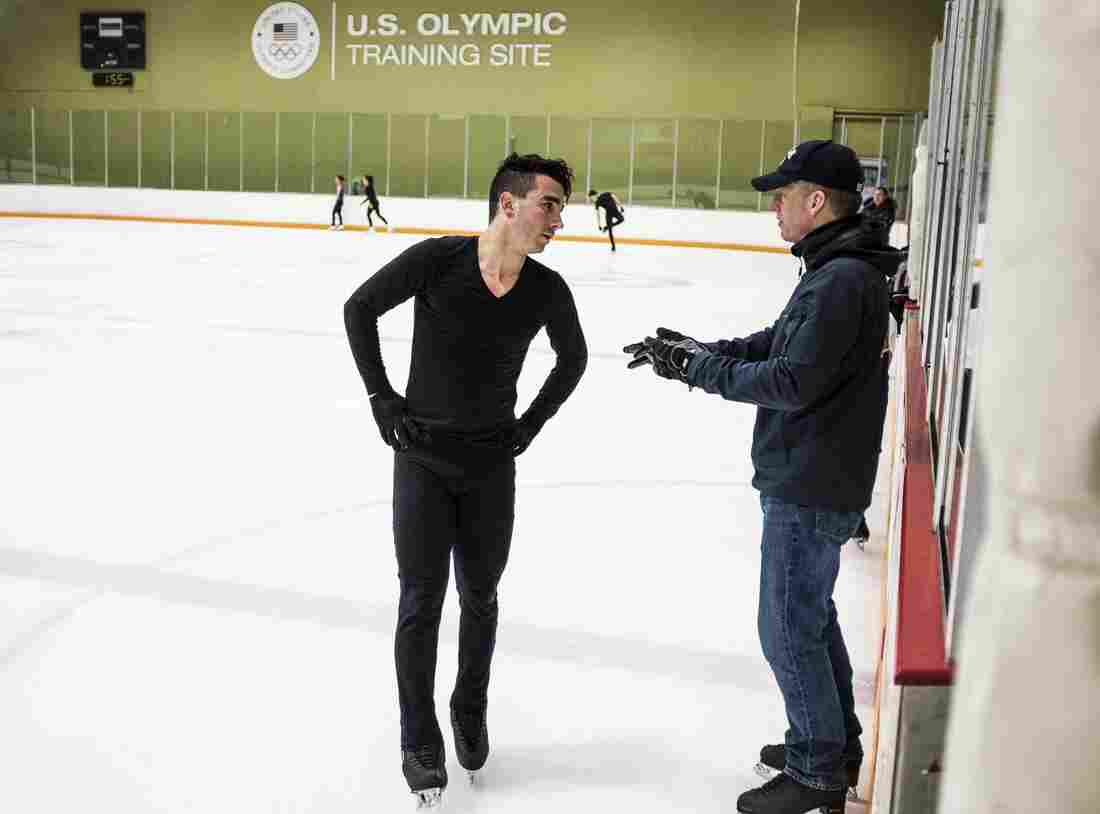
2013 Figure skating national champion and Olympic hopeful Max Aaron trains at the World Arena Ice Hall in Colorado Springs. Aaron recently graduated with a degree in finance.
Matt Nager for NPR
hide caption
toggle caption
Matt Nager for NPR
Max Aaron may have been the 2011 men’s junior figure-skating champion, 2013 U.S. national champion and 2015 Skate America champion. And sure, he’s a top contender for a spot on the U.S. team in next month’s Winter Olympic Games in PyeongChang, South Korea.
But all his grandfather wants to know is when he’s going to machan a leibedik—Yiddish for “make a living.”
Before he can do that, though, Aaron and many other elite athletes face a big hurdle: Finding time, between all that training — hours in the gym or pool or on the ice — to earn a college degree.
Aaron, who is 25, has been working on it — for years — balancing his grueling training schedule with classes in finance at the University of Colorado Colorado Springs.
A onetime hockey player who switched to figure skating after breaking his back in high school, Aaron took his competitive nature with him to the university, where he was determined to outdo his classmates.
This story was reported for radio by Elissa Nadworny and for the web by Jon Marcus of the Hechinger Report.
“I look at, they got a 99 — I’m going to get 100,” he says during a break from the rink in the World Arena Ice Hall, where aspiring and elite Olympic skaters train.
That doesn’t mean it was easy. Because of his skating career, he hadn’t ever taken the SAT or ACT, so he had to start at community college. He worked as a a waiter on the weekends to help pay the tuition. To accommodate his three hours a day at the rink, plus warmup time, strength conditioning, physical therapy and dance, he typically took his finance classes from 8 to 10:40 a.m. and 7:30 to 10:05 p.m.
Max Aaron talks with his coach, Tom Zakrajsek, during practice at the World Arena Ice Hall in Colorado Springs.
Matt Nager for NPR
hide caption
toggle caption
Matt Nager for NPR
“I laid out my entire schedule,” he says. ” ‘And these are my breaks and this is when the courses meet and where I can fit them in.’ ” Universities “don’t work around you,” he says, “you work around them.”
Meeting the needs of older students
Olympic athletes and hopefuls comprise only a tiny handful of the older students trying to get higher educations. But their struggles with finding the money and time to do it, among other problems, illustrate the problems legions of adults are facing.
American higher education long ago stopped being primarily for the 18-year-old undergraduate, tossing a Frisbee on a manicured quadrangle.
Sixty percent of undergraduates today are over 25, working full time, financially independent of their parents, or connected with the military, according to the American Council on Education. That’s nearly 16 million people.
As the number of 18-year-olds declines, colleges and, eventually, employers, are becoming more dependent on this older group to fill classrooms and jobs. And the supply of them is vast. One in five American adults has earned some college credit, but never finished a degree, the American Academy of Arts & Sciences reports.
Yet exactly at the time when more nontraditional-aged adults are needed to go to college, institutional and government policies make that harder than trying to skate uphill.
Compared with most of these older students, Olympic athletes and hopefuls have some help. In August, Colorado made them eligible for lower in-state tuition at community colleges and public universities; 56 athletes are already taking advantage of that. There are 500 athletes in residence at the U.S. Olympic Training Center, chosen by the governing bodies of their sports.
In 2014, the U.S. Olympic Committee began offering college scholarships, using money it receives from donors. And athletes can take online courses for free from the for-profit DeVry University, a USOC sponsor.
Thirty-seven student-athletes have graduated, and there are another 118 enrolled. (About 1,600 paying students at DeVry have filed claims for loan forgiveness, saying the school defrauded or misled them, according to the Century Foundation, a nonpartisan think tank, and its parent company has reached a tentative deal to sell it.)
“The athletes are a little bit at the forefront of this,” says Leslie Klein, the USOC’s director of athlete career and education. She’s a former two-time Olympian who competed in kayaking and canoeing. Veteran athletes with multiple trips to the Olympics, she says, “are just trying to chisel away at their educations [and] we’re trying to make it a little easier for them.”
In many ways, it’s still tough. The USOC last year awarded $236,000 in tuition scholarships, for instance, but the amount requested was four times that much. Only 80 athletes got them out of 120 who applied.
Leslie Klein, director of the athlete career and education program the U.S. Olympic Committee.
Matt Nager for NPR
hide caption
toggle caption
Matt Nager for NPR
Then there are the time constraints. Olympic hopefuls train so incessantly that their training is often the equivalent of a full-time job. On top of that, they travel often to compete. And many older athletes juggle families and jobs on top of all that.
Elana Meyers Taylor is a bobsledder with two Olympic medals: bronze in Vancouver and silver in Sochi. It took her four years to get her master’s in sports administration, and then she started studying online for an MBA.
Bobsled competitions are often held in tiny ski towns around the world, which made studying hard in places without reliable wireless service.
“You can imagine getting an online degree is pretty difficult,” she says.
She’d work on her academics during travel time and at night. “I’d get a couple of hours in and study here and there,” Meyers Taylor says. She got her MBA in finance in 2015.
“It’s not easy,” she says of combining work, study and international competition. “I’m not going to say … I wanted to sit down and read about the stock market” after every race. “It’s about setting a goal and keeping that long-term perspective.”
Jennifer Page, a 2020 Olympic hopeful in women’s wrestling, just finished an undergraduate degree in health sciences and strength and conditioning at the University of Colorado Colorado Springs, or UCCS.
“I would wake up, I’d have class at 8 a.m., I had practice at 10. I’d eat, shower, go back to school from 1 to around 3:30 and then have practice again from 4 to 6 p.m. and I’d go home and eat, shower, do homework and go to bed. And that was my day.”
Page earned some credits at Oklahoma City University, where she spent a year on a wrestling scholarship but quit to train for London with the Olympic team. It took her six years to earn her bachelor’s degree.
Page was amused to hear her younger classmates complain about how hard college was.
Team USA wrestler Jennifer Page trains in a pool at the Colorado Springs Olympic Training Center. She is recovering from an ACL surgery.
Matt Nager for NPR
hide caption
toggle caption
Matt Nager for NPR
“I think how easy it would be if all I had to do was go to school,” she says. “Life seems so simple when all you have to do is show up for school and do your homework.”
Figure skater Mirai Nagasu also hopes to return to the Olympics — she came in fourth in Vancouver in 2010, when she was just 16.
“Whenever I have a break, I’m back on my computer and studying,” says Nagasu, now 24. She’s in the equivalent of her junior year, on her way to a bachelor’s degree in international business at UCCS. “It is so beyond difficult to balance it all. During finals week I don’t get a lot of sleep and I tell myself, ‘I can’t do this anymore.'”
But she and other Olympic athletes do, because they know their competitive years will someday end.
“An athlete ends up at the pinnacle of a career sometimes as early as their late 20s and they’ve never known a life outside of sport,” says Leslie Klein, who interrupted her own education to compete before later earning undergraduate and graduate degrees. “If they haven’t gone to school, they have nothing to lean on in terms of a career outside of sport.”
That’s what keeps Max Aaron focused on fulfilling his grandfather’s wishes.
“I have met a lot of athletes who were on the top of their sport, and then sat around and did nothing. They just didn’t know what to do,” he says. “It eventually ends, and that’s what I think a lot of athletes forget. It’s 10 years after the Olympics and you won the Olympics and that’s great, but no one cares.”
Figure skater Mirai Nagasu at the World Arena Ice Hall in Colorado Springs.
Matt Nager for NPR
hide caption
toggle caption
Matt Nager for NPR
His graduation ceremony last month was held in the arena next to the rink where he trained. His grandfather couldn’t make it, but his parents did.
After he received his degree, he went back to the locker room, changed clothes, and got back on the ice to train some more.
This story was produced with The Hechinger Report, a nonprofit, independent news organization focused on inequality and innovation in education.
Let’s block ads! (Why?)







